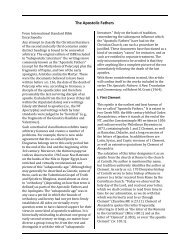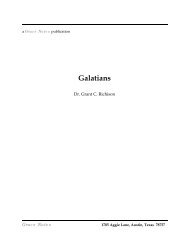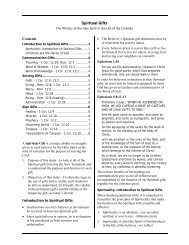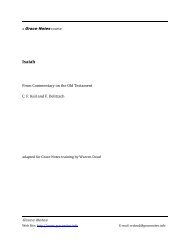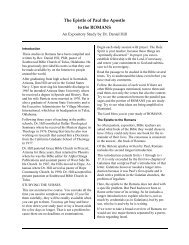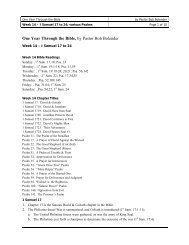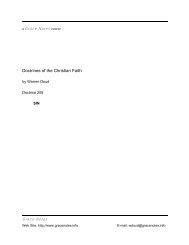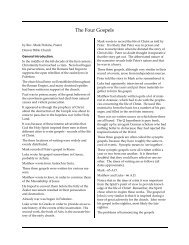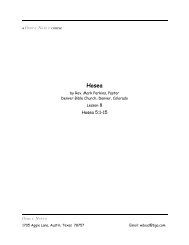Song of Solomon - Grace Notes
Song of Solomon - Grace Notes
Song of Solomon - Grace Notes
You also want an ePaper? Increase the reach of your titles
YUMPU automatically turns print PDFs into web optimized ePapers that Google loves.
SONG OF SOLOMON Page 27By C. F. Keil and F. Delitzscha <strong>Grace</strong> <strong>Notes</strong> study(Symm. φ ώσε ς), and like lacunae, whencelacunaria, for which Jerome has here laquearia,which equally denotes the wainscot ceiling.,מרזבים Abulwalîd glosses the word rightly bygutters (from הַ ט ,רָ to run); only this and ἱά <strong>of</strong> the Gr. Venet. is not anarchitectural expression, like ,רהיטים which isstill found in the Talm. (vid., Buxtorf’s Lex.). To,חָ רַ ט from ,חריטנו suppose a transposition fromto turn, to carve (Ew., Heiligst., Hitz.), isבְׁ רותִ ים in ת accordingly not necessary. As thebelongs to the North Palest. (Galilean) form <strong>of</strong>speech, so also ח for ה in this word: an exchange<strong>of</strong> the gutturals was characteristic <strong>of</strong> theGalilean idiom (vid., Talm. citations by Frankel,Einl. in d. jerus. Talm. 1870, 7b). Well knowingthat a mere hut was not suitable for the king,Shulamith’s fancy converts one <strong>of</strong> themagnificent nature-temples <strong>of</strong> the North Palest.forest-solitudes into a house where, oncetogether, they will live each for the other.Because it is a large house, although not largeby art, she styles it by the poet. plur. bāattenu.The mystical interpretation here finds in Isa.60:13 a favourable support.<strong>Song</strong> <strong>of</strong> <strong>Solomon</strong> 2<strong>Song</strong> 2:1. What Shulamith now further saysconfirms what had just been said. City andpalace with their splendour please her not;forest and field she delights in; she is a tenderflower that has grown up in the quietness <strong>of</strong>rural life.1 I am a meadow-flower <strong>of</strong> Sharon,A lily <strong>of</strong> the valleys.We do not render: “the wild-flower,” “the lily,”… for she seeks to represent herself not as theone, but only as one <strong>of</strong> this class; thedefiniteness by means <strong>of</strong> the article sometimesbelongs exclusively to the second number <strong>of</strong> thegenit. word-chain. מלאך ה׳ may equally (vid., at1:11, Hitz. on Ps. 113:9, and my Comm. on Gen.9:20) mean “an angel” or “the angel <strong>of</strong> Jahve;”and בת׳ יש׳ “a virgin,” or “the virgin <strong>of</strong> Israel”(the personification <strong>of</strong> the people). Forhhăvatstsĕlĕth (perhaps from hhivtsēl, a denom.quadril. from bĕtsĕl, to form bulbs or bulbousknolls) the Syr. Pesh. (Isa. 35:1) useschamsaljotho, the meadow-saffron, colchicumautumnale; it is the flesh-coloured flower withleafless stem, which, when the grass is mown,decks in thousands the fields <strong>of</strong> warmerregions. They call it filius ante patrem, becausethe blossoms appear before the leaves and theseed-capsules, which develope themselves atthe close <strong>of</strong> winter under the ground. Shulamithcompares herself to such a simple and commonflower, and that to one in Sharon, i.e., in theregion known by that name. Sharon is peraphaer. derived from רון .יְׁשָ The most celebratedplain <strong>of</strong> this name is that situated on theMediterranean coast between Joppa andCaesarea; but there is also a trans-JordanicSharon, 1 Chron. 5:16; and according toEusebius and Jerome, there is also anotherdistrict <strong>of</strong> this name between Tabor and theLake <strong>of</strong> Tiberias, which is the one hereintended, because Shulamith is a Galilean: shecalls herself a flower from the neighbourhood<strong>of</strong> Nazareth. Aquila translates: “A rosebud <strong>of</strong>Sharon;” but שושַ נָ ה (designedly here the fem.form <strong>of</strong> the name, which is also the name <strong>of</strong> awoman) does not mean the Rose which wasbrought at a later period from Armenia andPersia, as it appears, and cultivated in the East(India) and West (Palestine, Egypt, Europe). Itis nowhere mentioned in the canonicalScriptures, but is first found in Sir. 24:14;39:13; 50:8; Wisd. 2:8; and Esth. 1:6, LXX. Sinceall the rosaceae are five-leaved, and all theliliaceae are six-leaved, one might suppose,with Aben Ezra, that the name sosan (susan) isconnected with the numeral ש ,שֵ and points tothe number <strong>of</strong> leaves, especially since one iswont to represent to himself the Eastern liliesas red. But they are not only red, or ratherviolet, but also white: the Moorish-Spanishazucena denotes the white lily. The root-word,שֵ ש will thus, however, be the same as that <strong>of</strong>byssus, and יִש ,שַ white marble. The comparison



